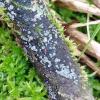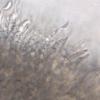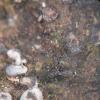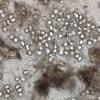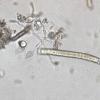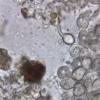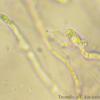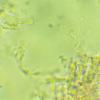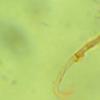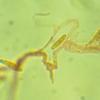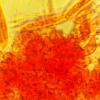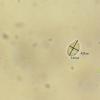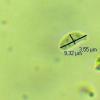
09-11-2025 13:20
Hello.A tiny ascomycete, appearing as erupting gra

08-11-2025 00:29
 Francois Guay
Francois Guay
I found this species in Quebec, Canada, on herbace

04-11-2025 09:07
Hello.A suspected Hymenoscyphus sprouting on a thi

04-11-2025 12:43
 Edvin Johannesen
Edvin Johannesen
Hi! One more found on old Populus tremula log in O

03-11-2025 21:34
 Edvin Johannesen
Edvin Johannesen
These tiny (0.4-0.5 mm diam.), whitish, short-stip
While microscopically examining some fruiting bodies on wood that I could identify as Mollisia fusca, I observed two strange phenomena ... I don't know if there is a connection between the two.
1) After taking photos of asci, paraphyses and spores of the mollisia (photo 1a), I found where normally the hymenium is, conidiogenic structures with lacrymoid conidia 9 x 2.7 µm) (photos 1b-1c):
2) Three days later, the hymenium of most of the fruiting bodies (photo 2a) was seemingly gone or heavily affected by presumably a parasite? Conidia globose to amygdaliform with sometimes a kind of pedicel: 11-15 x 7-9 µm.
Does anyone have experience with these phenomena or perhaps a possible cause.
Many thanks for any information,
François Bartholomeeusen

Dear Zotto,
Thank you for your quick reply. A "chytrid" is unknown to me, and does that refer to 2) the "conidia" 11-15 x 7-9 µm
Warm regards,
François

here are some Danish records of chytrids:
https://svampe.databasen.org/observations/10259245
https://svampe.databasen.org/observations/10256834


Thanks, while I was formulating my reply you already delivered the publication ... "faster than his own shadow !!!"
To Thomas,
many thanks the pictures in the link Chytridiomycota are identical to mine point 2)
To Zotto,
I now have a lot to think about and study. Browsing through your "Ascomycetes illustrations" I found my own photos of the item on Ascofrance with this link: http://www.ascofrance.com/search_forum/45936
I think I can say on behalf of many Ascofrance nembers that we are very grateful to you for making your wealth of information freely available. Thanks again!
François

a few days ago I met the alleged Tremella discicola on some Pyrenopeziza sp. (?) on a blade of grass. If my guess is correct, perhaps it is a complex of species specialized for different hosts? By no means the spores in my collection are not globose.
Regards - Przemek
here is an example of a hitherto undescribed Syzygospora sp. hosted by what I have been able to determine is Hymenoscyphus scutula:
https://www.bio-forum.pl/messages/33/1035877.html
Forgive me everyone, I know this forum is about Ascomycetes, but as you know many species of "Heterobasidiomycetes" are closely related to ASCO. :-)
Przemek


